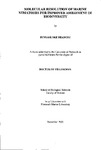MOLECULAR RESOLUTION OF MARINE NEMATODES FOR IMPROVED ASSESSMENT OF BIODIVERSITY
| dc.contributor.author | BHADURY, PUNYASLOKE | |
| dc.contributor.other | School of Biological and Marine Sciences | en_US |
| dc.date.accessioned | 2013-11-07T11:18:58Z | |
| dc.date.available | 2013-11-07T11:18:58Z | |
| dc.date.issued | 2005 | |
| dc.identifier | NOT AVAILABLE | en_US |
| dc.identifier.uri | http://hdl.handle.net/10026.1/2658 | |
| dc.description.abstract |
Free-living nematodes are abundant in all marine habitats, highly diverse and can be important ecological indicators for monitoring anthropogenic impacts on the environment. Despite such attributes, nematode diagnostics has traditionally relied on detailed comparison of morphological characters which is often difficult and laborious, and as a result there is an increasing 'black hole' in faunal inventories where the biodiversity of groups such as nematodes is typically underestimated. Molecular methods offer a potentially efficient alternative approach to studying the biodiversity of marine nematode communities, and the main focus of this thesis was to apply molecular ecological tools for improved understanding of nematode diversity in marine and estuarine environments. Denaturing gradient gel electrophoresis (DGGE) has been evaluated as a novel tool for the identification of marine nematodes and for rapid assessment of their diversity based on amplification of the nuclear 18S rRNA gene. This approach successfully identified nematode taxa based on banding pattern and was also able to detect the most abundant taxa in samples from marine and estuarine environments. A DNA barcoding approach based on the 18S rRNA gene was applied for the first time in marine nematology, in an attempt to speed up the identification process. The success rate of this approach, across a range of nematode groups, was found to be close to 97%. A combined morphometrics and molecular approach was also undertaken to investigate cosmopolitanism and cryptic speciation by analysing populations of a cosmopolitan marine nematode, Terschellingia longicaudata, from different geographical regions. Results suggest that Terschellingia longicaudata is indeed truly cosmopolitan, with a wide geographic distribution. Two haplotypes that were divergent from most T. longicaudata were also identified in this study, indicating possible novel cryptic lineages or previously undescribed species of the genus. The final focus of this thesis was to develop methods for the molecular investigation of nematodes stored in formalin and other organic compounds. The effectiveness of formalin as a short term preservative was first evaluated, since this would allow morphological and molecular work to be conducted on the same specimen. Amplifiable DNA could be routinely obtained from specimens stored in formalin for periods of up to nine days. In addition the effectiveness of other organic solvents for the preservation of both molecular and morphological integrity of marine nematodes was investigated. The final part of this study developed and optimized a novel DNA extraction technique that could be employed to recover DNA from archived formalin fixed marine nematode specimens so as to carry out subsequent molecular analysis such as PCR amplification and sequencing. | en_US |
| dc.description.sponsorship | Plymouth Marine Laboratory | en_US |
| dc.language.iso | en | en_US |
| dc.publisher | University of Plymouth | en_US |
| dc.title | MOLECULAR RESOLUTION OF MARINE NEMATODES FOR IMPROVED ASSESSMENT OF BIODIVERSITY | en_US |
| dc.type | Thesis | |
| plymouth.version | Full version | en_US |
| dc.identifier.doi | http://dx.doi.org/10.24382/3767 | |
| dc.identifier.doi | http://dx.doi.org/10.24382/3767 |
Files in this item
This item appears in the following Collection(s)
-
01 Research Theses Main Collection
Research Theses Main


